Where to Stay in Mexico City: Guide for First Timers
The absolute first thing you need to know as you get into planning your trip to Mexico City, which is ostensibly why you’re here, is that Mexico City is huge. Despite having been to Mexico City several times over the past few years, the density of the city continually blows my socks off.
Choosing a place to stay is going to be an important decision that has major implications for your trip. For example, because of that density, it takes forever to go just about anywhere in the city between around 12pm and 7pm on a weekday.
So if you’re in town with a limited amount of time – say a week or less – you’re going to want to stay relatively central in order to minimize the number of times you need to make long journeys across the city.
Trust us on this one – we once spent part of a trip in Coyoacán which is both extremely charming and also extremely inconvenient for getting to just about everything in the city. We loved staying down there, but it was certainly not the most convenient place to stay with limited time.
Like most big cities, each neighborhood in Mexico City has a distinct look and feel, from the leafy streets of Roma Norte, to the lush parks of La Condesa, and the charming cobblestone streets of Coyoacán.
In this guide to where to stay in Mexico City, we’re going to use our experiences exploring the city over multiple weeklong trips to cover our favorite places to stay.
Each offers a different blend of vibes, prices, and pros and cons, and we’ll cover it all below so that you’re armed with all the information you need to figure out where to stay for your particular style and budget.
Sound good to you? Let’s get into it.
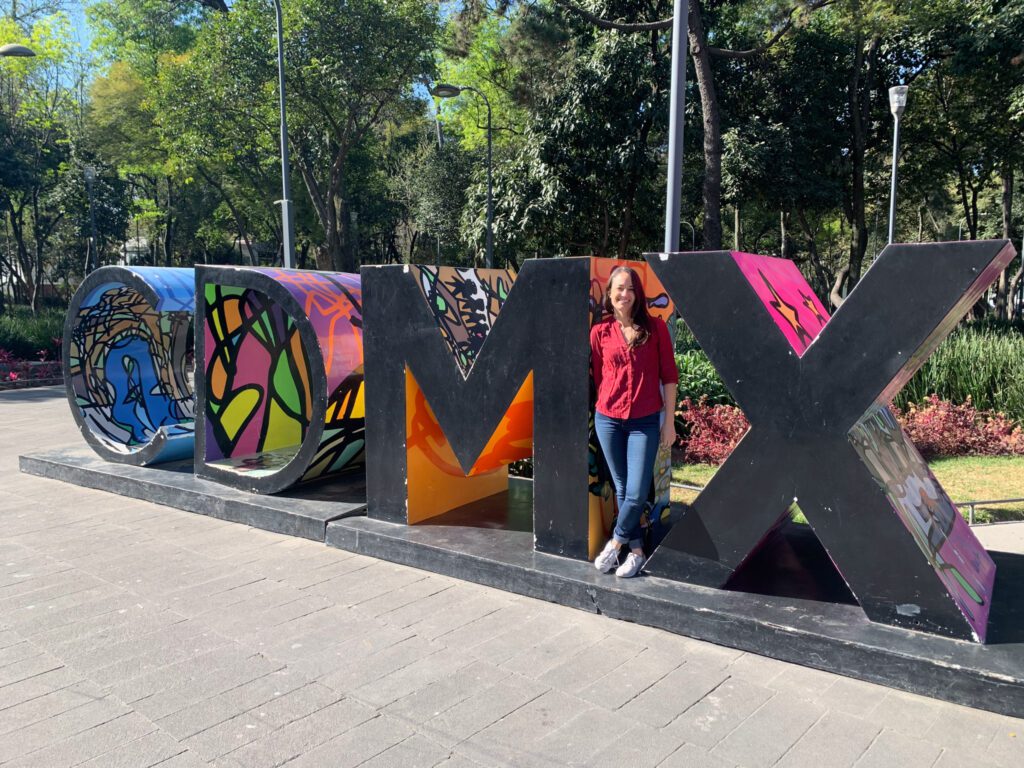
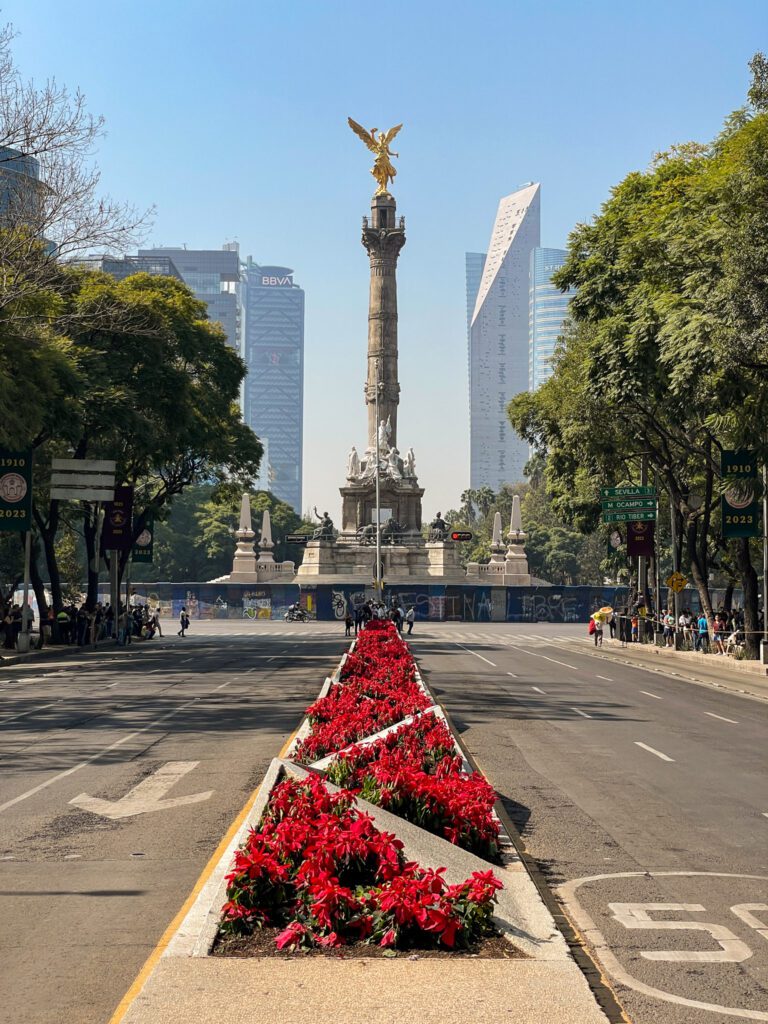
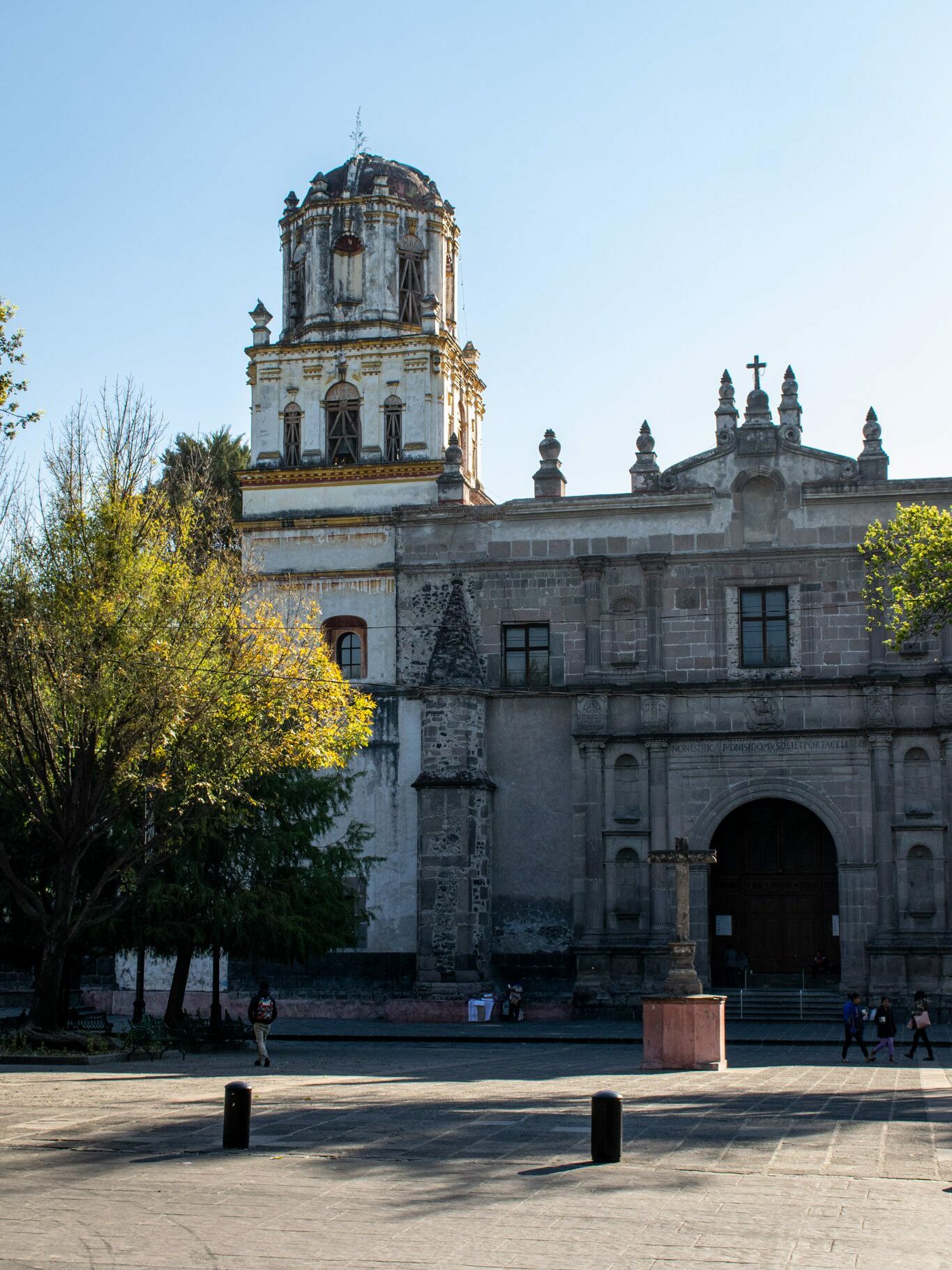
Important note: this is a long guide with lots of detail (it got longer and longer as we put it together), but we’ve done our best to structure is with headings, a helpful summary at the top, and a table of contents to help you navigate it without reading literally every word.
Disclaimer: Some of the links in this post, like hotel links, are affiliate links, meaning at no additional cost to you, we make a little bit of money if you click through and book. That being said, we would never recommend something to you that we don’t stand behind 100%.
Where to Stay in Mexico City: 4 Great Places to Stay
Our philosophy when it comes to deciding on a place to stay is to first choose the neighborhood, then move on to finding a great hotel, hostel, or apartment in that area.
The beauty of Mexico City, like most big cities, is that each neighborhood has a unique personality. The best neighborhood in Mexico City for you totally depends on what you’re looking for.
The downside of that fact is that it can be REALLY confusing when it comes time to decide on where to stay.
With so many great neighborhood options, each with their own quirks and unique charm, which area should you choose?
It seems impossible to choose in a city as big and sprawling as Mexico City, but we’ve narrowed down the list to just a handful of neighborhoods.
The reality is that, depending on what you’re looking for, there are other neighborhoods that probably meet your needs. But these are the ones that we think are the best for 99% of travelers, and we’ve shown our work, doing our best to explain why we think that.
For each of the neighborhoods below, we’ve created a structure to help you figure out if it’s the right home base for you. Here’s what we’ll cover:
- An overview of the neighborhood and our experience with it. We’ve personally been to and explored (more than once) all of the areas on this list, so we’ll try to give you a little bit of our perspective on what makes each area special.
- Pros and cons of staying in this area. The things you need to know to make your decision.
- A collection of a few places to stay that stood out to us. Sometimes it’ll be because they have rooms with Zocalo views, sometimes it’s that the hotel offers a great value given the location.
Now, we’re well aware that a few of you are currently ready to throw your left shoe at the screen, saying “I don’t have time to read all of that, JUST TELL ME THE BEST PLACE TO STAY!”
Well, here’s a quick summary of this guide if you’re short on time (though we’d recommend reading the section of the place you end up staying for tips and places to add to your list!).
A quick spoiler here: as you’ll read below, there are three neighborhoods that, in our mind, clearly stand out above the rest. They form a central triangle between the Centro Histórico, Bosque de Chapultepec, and Coyoacán to the south (which are the main places you’re going to be visiting on your trip).
Those three neighborhoods are Roma Norte, La Condesa, and Juárez.
- Our top overall recommendation is the charming, tree-lined streets of Roma Norte. Every time we’re in Mexico City we spend the most time in Roma Norte, whether we stay there or not. It’s charming, full of our favorite places to eat and drink in Mexico City, is the starting point for a bunch of fun experiences (like cooking classes and coffee or mezcal tastings), and you can walk to pretty much everything. The downsides are that it’s expensive and, as a result, heavily gentrified and full of tourists and expats. In terms of places to stay, there are a couple of nice guesthouses – Roso Guest House and Ignacia Guest House – that we put on our list for our next trip. If you want an apartment with more space and a kitchen, go with UTOPIC by ULIV.
- La Condesa is a close second, with an equally excellent vibe and two big parks. Pretty much everything we said about Roma Norte applies here, though it’s even more upscale than La Roma (the name means “the countess” if that tells you anything). We heard more English walking the streets of La Condesa than anywhere else in Mexico City. However, between the parks, the tree-lined street that runs around the parks, and the wide array of places to eat and drink from traditional tacos and tortillerias to upscale natural wine bars, it’s a great home base. If you want our top pick, it’s the Red Tree House (they’ve been sold out both times we’ve tried to stay there), which is a fun, affordable guesthouse a few blocks from Parque México. Our favorite hotel here is the gorgeous Casa Decu. If you want an apartment with more space, Be Mate Condesa Hipódromo is your best bet.
- Juárez is a slightly more budget-friendly neighborhood with a similarly great location and selection of places to eat and drink. However, despite the close proximity, it’s not on nearly as many tourist’s radar, which means it’s a little more affordable than Condesa and Roma Norte. It’s more of a concrete jungle, with some of Mexico City’s biggest skyscrapers.
- If you’re traveling with family, we’d choose either Roma Norte, La Condesa, or Coyoacán. The latter is a little further out, which isn’t convenient for short trips, but it’s a former small colonial town that has since been swallowed up by Mexico City’s expanding urban sprawl that offers a completely different vibe and price point.
Here’s a map to help you visualize what we’re talking about, with the neighborhoods we’re going to talk about in this guide along with some key landmarks (the yellow stars) to help you understand the geography of the city.
Roma Norte: Our Top Recommendation for First Time Visitors
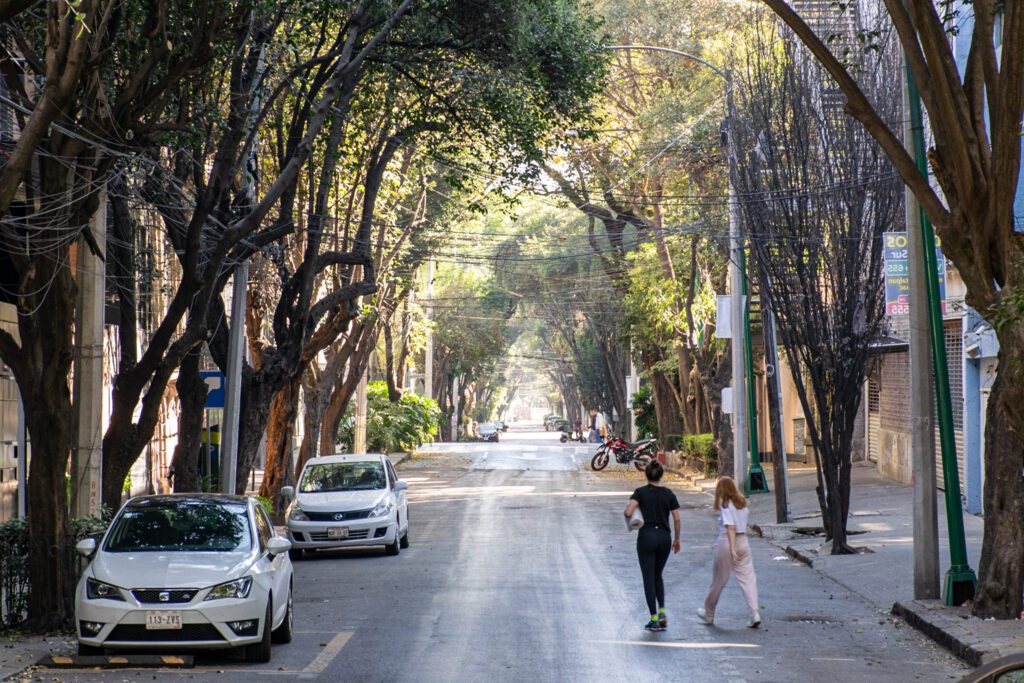
Rome Norte is where we stayed for the majority of our first two trips to Mexico City and I (Matt here!) stayed just a hair south in Roma Sur when I brought my two brothers to the city to share it with them.
That should make it fairly obvious that Roma Norte is pretty clearly our favorite place to stay.
Colonia Roma is a historic neighborhood that sits just southwest of Mexico City’s Centro Histórico. Unlike La Condesa, which is a little more free-flowing in terms of its urban design, Roma Norte is laid out on a grid, which is a nod to its relatively modern creation.
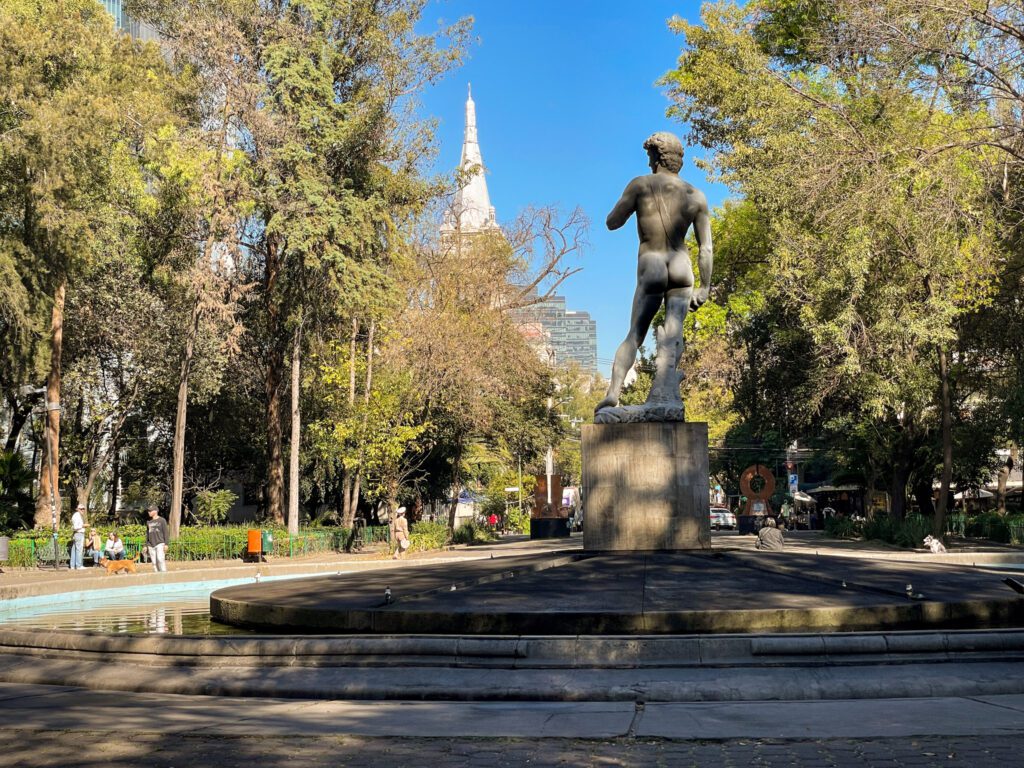
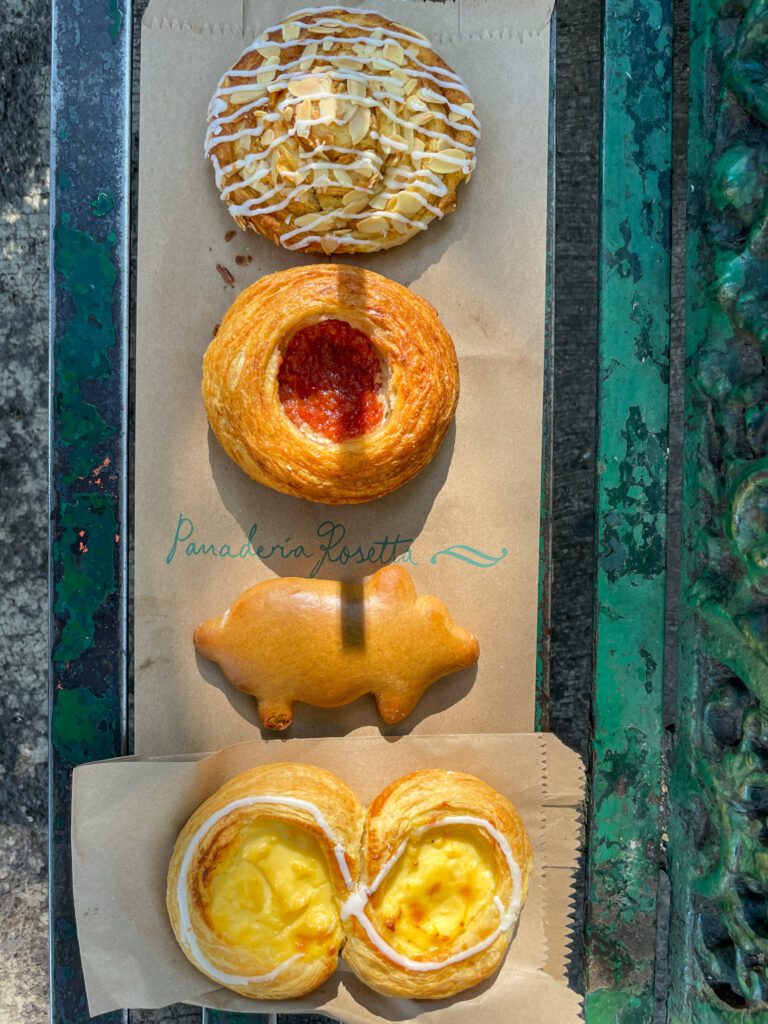
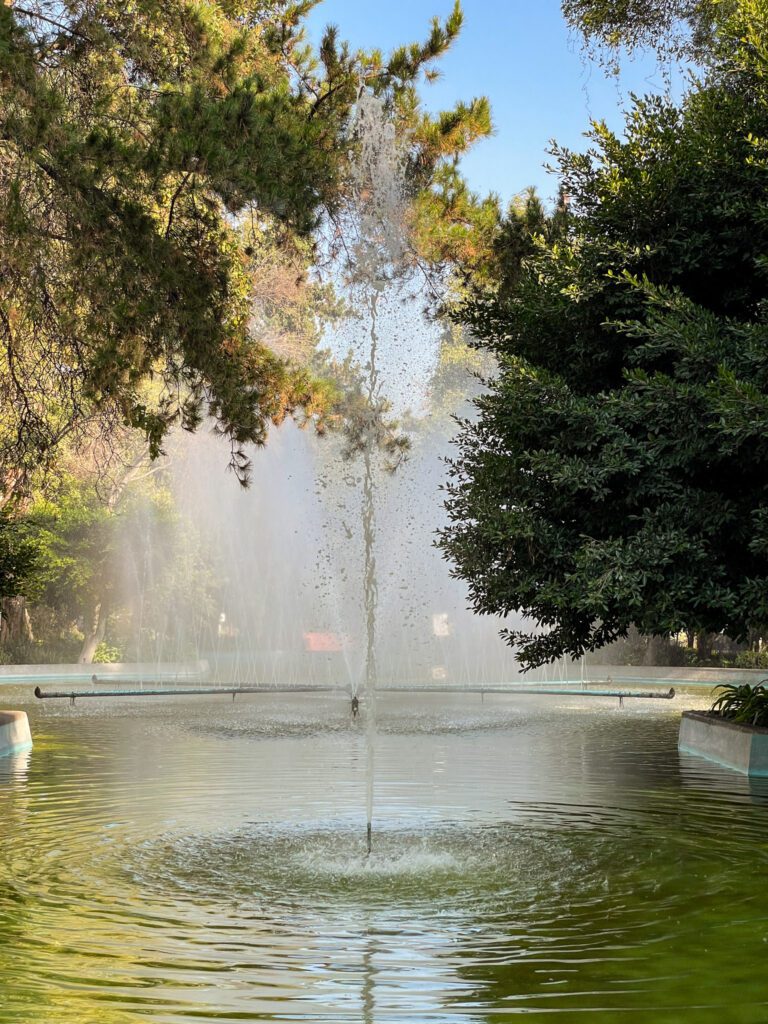
As you walk around Rome Norte, you might notice that it feels fairly European, with a few wide boulevards and tree-lined streets with shops, cafes, and restaurants on the ground floor and apartments on the top floors.
There’s a reason for that: it started as a wealthy suburb (of sorts) just outside the city center where wealthy aristocrats – mostly Europeans – gathered.
That golden age of Roma continued until the 40’s or 50’s when the neighborhood started to decay as wealthy residents moved elsewhere and it became more of a working class neighborhood.
Until the 1985 earthquake, that is, which destroyed large swaths of the neighborhood and took decades to fully recover from. Starting in the 2000’s, artists and small businesses began to come back to Roma, which brought about the Renaissance that it is seeing at the moment a decade or so later.
Today, Colonia Roma has been split in half into aptly-named Roma Norte and Roma Sur. Roma Norte is the more charming and convenient of the two, and is our recommendation.
We particularly like the area on the northern end of Roma Norte within a few blocks of Avenida Álvaro Obregón, a main thoroughfare that runs east-west through the neighborhood.
The two biggest downsides are directly related to the area’s popularity in recent years.
First, it’s very popular and trendy with both expats and tourists, and you’re likely to hear more English here (and in La Condesa) than in any other part of Mexico City.
Second, that popularity means that the relatively few places to stay in Roma Norte are expensive.
Still, Roma Norte is equal parts charming, convenient, and full of places to eat and drink, which puts it at the top of our list of Mexico City’s best places to stay.
Roma Norte’s low point after the 1985 earthquake led to low rents that eventually attracted students, artists, and other young people.
In a tale as old as time, the area became more and more popular, and eventually the effects of gentrification set in, pushing out local residents and businesses in favor of tourists and expats (and the businesses that cater to them).
We’re not solving gentrification here, but it’s something to be aware of as you plan your trip and make your decision on where to stay. We would say to avoid using Airbnb here, though, because Airbnb rents out units to tourists that could otherwise be used for housing people who actually live here.
Pros and Cons of Staying in Roma Norte
Here are the pros and cons of staying in Roma Norte as we see them.
Pros of Staying in Roma Norte
- It’s a very convenient location. As one of the trio of neighborhoods that make up our overall recommendation, it’s easy to go from Roma Norte to basically anywhere else in the city. There are several metrobus lines running through it, a metro line runs down the eastern edge of the neighborhood (near the hospital), and everything else is a relatively short Uber ride away.
- It’s very walkable. We stayed in Roma Norte on our first extended trip to Mexico City, and aside from trips to the Centro Histórico and Coyoacán, we walked everywhere. Including across the park to Polanco. Everything in La Condesa and Juárez will be within ~30 minutes on foot, and most of our favorite coffee shops in Mexico City, restaurants, and bars are even closer than that.
- The streets are charming and leafy. On our last trip we stayed in Roma Sur, and one afternoon as we walked south from Roma Norte, we noticed how the neighborhood changed as we got out of the heart of Roma Norte, which largely caters to tourists. The streets of Roma Norte are leafy and green, shaded by the trees lining the streets. There are several big green spaces that provide another nice refuge. Overall, it’s a very charming area.
- There are a ton of great places to eat and drink. Of all the neighborhoods here, Roma Norte probably has the highest concentration of our favorite places to eat and drink. Which means you’ll be a short walk home after you dive into the world of mezcal at a bar near your hotel.
Cons of Staying in Roma Norte
- It’s expensive. As you might expect based on the great location, leafy streets, and places to eat and drink, this is one of the most desirable locations to stay in the city. Which means it’ll be relatively expensive. Sometimes not even relatively – we’ve seen rooms going for $400USD at some of the nicest places here. However, there are still some relative values to be had, and we’ve tried to lean that way in our hotel selections below.
- It’s full of expats and tourists. There’s no getting around it – like Brooklyn in NYC, the Mission in San Francisco, or Capitol Hill in Seattle, Roma Norte has gone through the cycle of gentrification and has become a neighborhood of relative newcomers as local residents have been pushed out due to rising housing costs. It’s not something to stop you from staying here, but it is definitely a consideration and something to keep in mind as you interact with people who live in CDMX and are feeling that pressure.
- There aren’t very many places to stay. Roma Norte is residential, which means that there aren’t all that many hotels and guesthouses to be had.
The Best Places to Stay in Roma Norte
In this section, you’ll find a few places to stay in Roma Norte that stood out to us as we were researching for both our own trip, and this guide.
Stanza Hotel
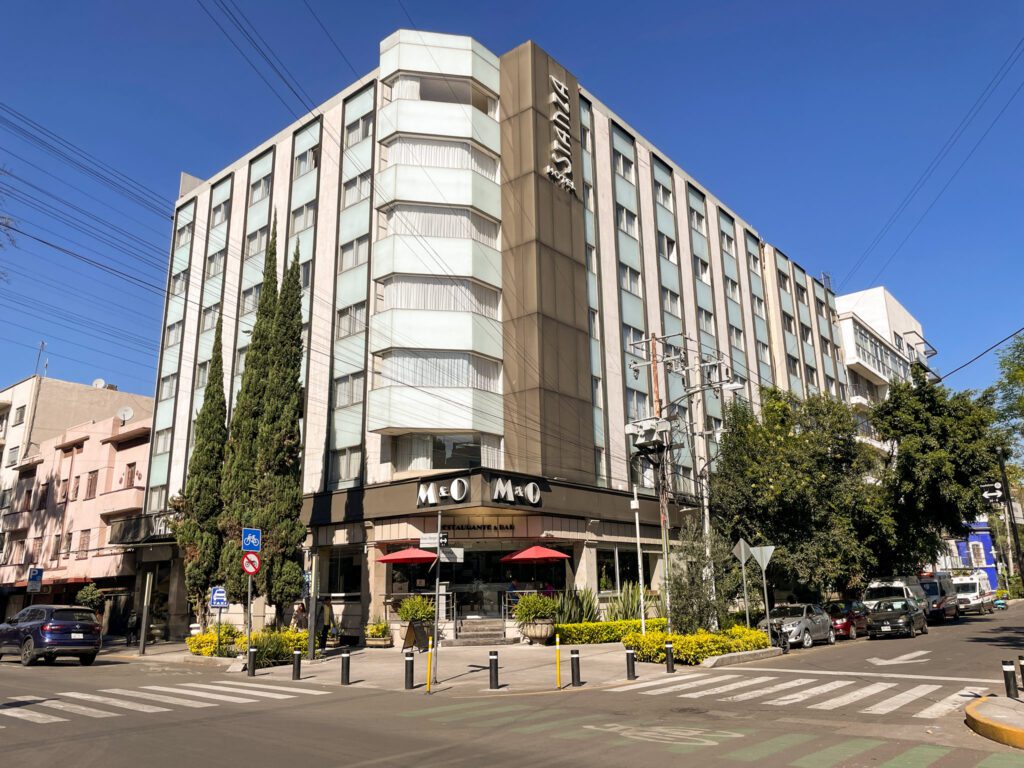
This solid mid-range hotel is on the eastern edge of Avenida Álvaro Obregón in Roma Norte, which is one of those wide European-style boulevards with a tree-lined walking path in the middle.
Though it’s on the eastern end of the neighborhood, which means it’s further away from places like La Condesa and Chapultepec Park, it is nicely located in a pocket of Roma Norte that has some great places to eat and drink (like Panaderia Rosetta, for example).
The hotel itself is big and modern. The thing to know here is that the rooms are nothing particularly special – they look like your standard hotel room in cities around the world – but they are a pretty great value considering the location.
Rooms come in a few different configurations: one double, two doubles, and one king, with a few suites that have more room to spread out.
There’s an onsite restaurant (that serves breakfast for an extra charge, but we’d recommend exploring the food options in the neighborhood instead) and a basic gym for you to use.
UTOPIC Roma Norte by ULIV
If you, like us, would prefer staying in an apartment-style room with a little more space to spread out and access to a kitchen, our top recommendation in Roma Norte is ULIV Roma Norte.
ULIV is the Mexican version of the companies we’ve encountered around the world who are creating “aparthotels,” which offer the convenience and amenities of a hotel (which you don’t get in a vacation rental) and the extra space and kitchen that you’ll find in an apartment.
We generally seek out Aparthotels when we travel because Matt needs access to a kitchen (he has Celiac Disease and often cooks meals for himself in places with few gluten free options) and we generally are staying awhile, so a little extra space is something we like to have.
In terms of location, we don’t think you could be better placed within Roma Norte if you stay here. You’re at the northwestern corner of Colonia Roma, which puts you a few blocks from both La Condesa and Juárez.
It’s basically walkable to everything in each of those three neighborhoods.
The apartments themselves can only be described as “industrial-chic” with exposed concrete walls and high ceilings. They’re fairly spacious – even the smallest one is 500 square feet – and they all come with a full kitchen, living area, and comfortable beds.
Some apartments have floor-to-ceiling windows that open up onto a compact balcony, and there are options for adjoining rooms for families who want to share a space.
In terms of amenities, you’ve got access to both a rooftop common area and a gym, and there’s onsite laundry for longer stays.
Roso Guest House
I walked by Roso Guest House three times in a row, thinking there would be signage telling me where to find it. It’s on a quiet street just north of Avenida Obregón, just a few blocks away from Plaza Río de Janeiro (with the fountain and the replica Statue of David).
The facade of the guesthouse blends into the unassuming streets it’s located on, which probably says something about what to expect if you stay here.
If you’re looking for a budget stay, this ain’t it. It trends more towards the luxury side of the spectrum in terms of both pricing and vibe.
It’s a small property with only a handful of rooms spread out through the tall skinny building, so you can be sure that it’s not going to be loud and boisterous when you try to go to bed at night.
They have a few room types, and the difference basically comes down to how much extra room there is to spread out, whether there’s a balcony or external space to enjoy on a warm sunny day, and, of course, price.
In terms of amenities, you have a basic complimentary breakfast available, onsite staff to help with planning and any issues that come up, and bikes to use to explore.
Ignacia Guest House
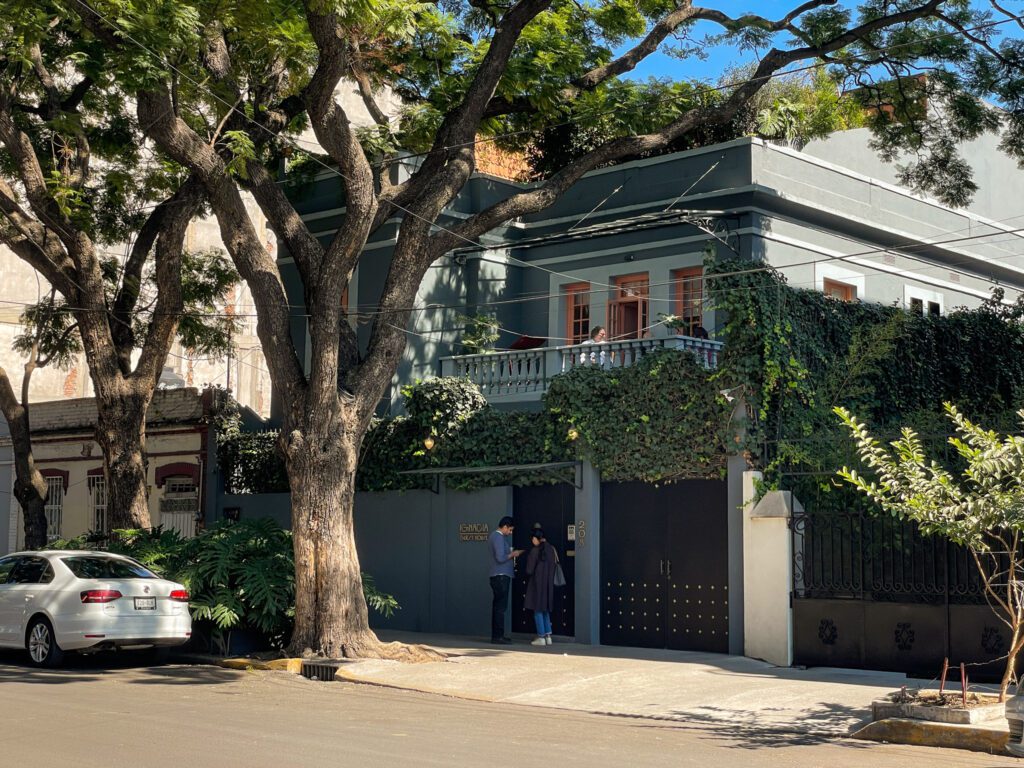
This charming guesthouse in the former home of an aristocrat, which was built in 1913 and has been lovingly restored by the team here, is a design-lover’s dream.
It’s a boutique hotel in the trendiest neighborhood in Mexico City, so it’s not going to be the cheapest option. But if you’re looking for a special stay for your trip, we’d put this place on the list.
In terms of location, you’re right in the middle of all the action here. You’ll have great bars, restaurants, and parks all within a few minutes of the front door (don’t miss Expendio de Maiz and Mis Mezcales!).
The thing that we like about Ignacia is the fact that it’s very much a bed and breakfast in the truest sense, meaning that you get both a bed and a (handmade) breakfast each morning.
There are just nine rooms at Ignacia, which makes it a much more intimate (not to mention quieter) experience than staying at one of the big hotels in the neighborhood. Each room is thoughtfully laid out and designed, and no two rooms are exactly the same.
Some rooms have more space and seating areas, some have balconies (some have both). Four of the rooms are themed around colors – Verde, Rosa, Amarilla, and Azul.
The grounds of the house are beautiful, with a lush, leafy garden to sit in to eat breakfast or spend a few minutes reading before you head out for the day.
One important note: No kids under 12 allowed, so stay elsewhere if you’re bringing your young kids with you.
Hotel MX Roma
There are, essentially, two highly rated mid-range hotels in all of Roma Norte, and Hotel MX is one of them. Hoteles MX is, as you might guess based on the name, a company with hotels all across Mexico, with a bunch of Mexico City hotels.
Of all of their locations within Mexico City, this is the best location. It’s two blocks away from Parque Rio De Janeiro, a couple of blocks from Av. Obregón, and within walking distance of most of the best pieces of Roma Norte.
In terms of value, this is hard to beat. There are three room types – single (one queen bed), double (two queen beds), and family suite (which is just two interconnected double rooms, so four beds total).
In terms of the rooms, the odd layout of the different room types almost seems closer to a hostel, with modern wood-paneled beds and desks. We’re into it, personally, but can see how it might be off-putting for a traveler looking for a more traditional hotel room layout.
The amenities here are also nice. There’s an outdoor terrace with tons of greenery and covered spaces to hang out and work/catch up on your book. There’s a small fitness center too, though it looks like it only has a couple of pieces of equipment in it.
If you’re looking for an affordable stay in a great location with a youthful energy, this is the spot!
Sonder Cielo
Sonder is a company that is similar to Airbnb in terms of your experience as a guest, but gets there a different way. Instead of connecting hosts who have an extra room or a guest suite with guests, Sonder has control over the units they’re renting out.
We’ve stayed in Sonder locations around the world, like in New York City and Madrid, and we like them for a few reasons.
First, it’s a very high-tech experience, with check-in happening exclusively through the app (which we know may not be for everyone). Second, their properties are almost always beautiful, with well-designed rooms and nice common areas.
The downside of Sonder is the fact that there are often limited staff onsite, which means if something goes wrong, it can take a second to get a resolution (you reach out to them via the app/email).
There’s also no daily housekeeping, which can be a downside if that’s what you’re expecting, but we generally decline daily housekeeping anyway.
Anyway, let’s talk about Sonder Cielo, which is their property in the heart of Roma Norte in Mexico City.
First of all, great location! It’s mere blocks from Fuente de Cibeles, a big round plaza where you’ll find Contramar and the famous tuna tostadas. It’s easily walkable to the metro at Glorieta de los Insurgentes, which is just a few blocks away, and it’s within walking distance of most things in Roma Norte.
They have a variety of apartments available, most of them studios of various levels (e.g. studio, superior studio, etc). They also have some one and two bedroom apartments if you want a little more space or are traveling with a group.
All apartments have basic kitchen amenities, including stovetops and refrigerators, and some apartments have private balconies.
Like many Sonder locations, the common areas here are beautiful. There’s a lovely outdoor terrace with tons of seating, and a compact gym if you want to get in a quick workout in between taco crawls.
La Condesa: Residential, Leafy, and Great Places to Eat and Drink (a Close Second)
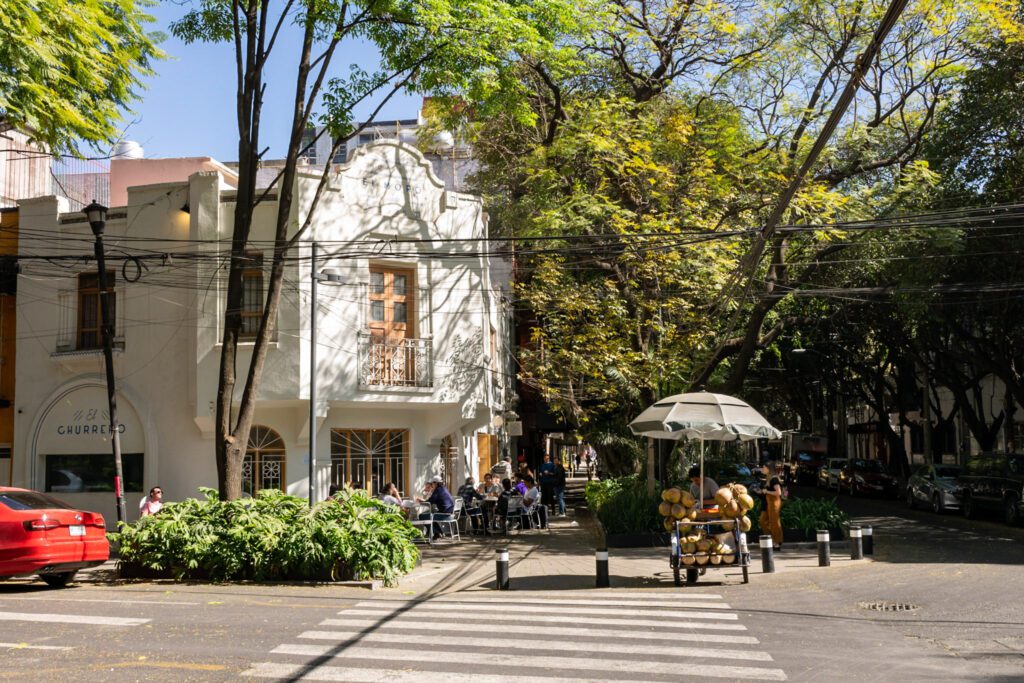
While Roma Norte is laid out on a grid, La Condesa is more free-flowing in its urban design. It’s centered around a large green space – Parque México – which forms the backbone of the neighborhood (along with smaller Parque España).
The neighborhood is sometimes referred to as “Condesa-Hipódromo,” and looking at a map tells you everything you need to know about why that name fits (particularly the second piece): it’s shaped like an oval, which is similar to horse racing tracks.
And, to our surprise, we learned that, yes, they did use the hippodrome that used to exist here for horse and car racing in the 20th Century.
Porfirio Díaz, the dictator who was in power in Mexico between the late 19th and early 20th Centuries, was particularly fond of the races held here, and used it to entertain his rich friends (who also lived in the neighborhood).
After the Revolution happened and Díaz fled to France, it was decommissioned and turned into a ring road around the park, which is what you see today (it’s roughly where Avenida Ámsterdam is now).
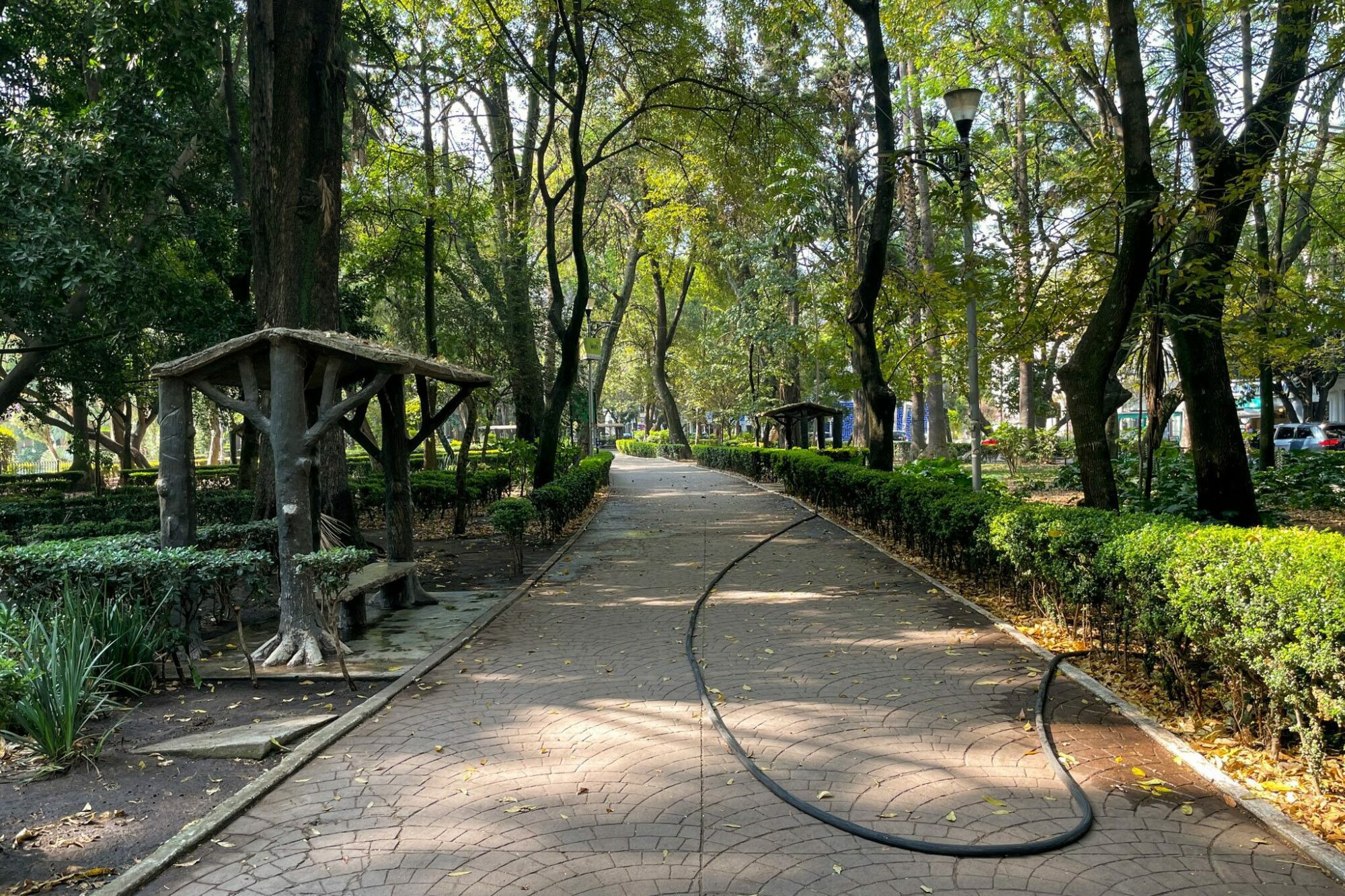
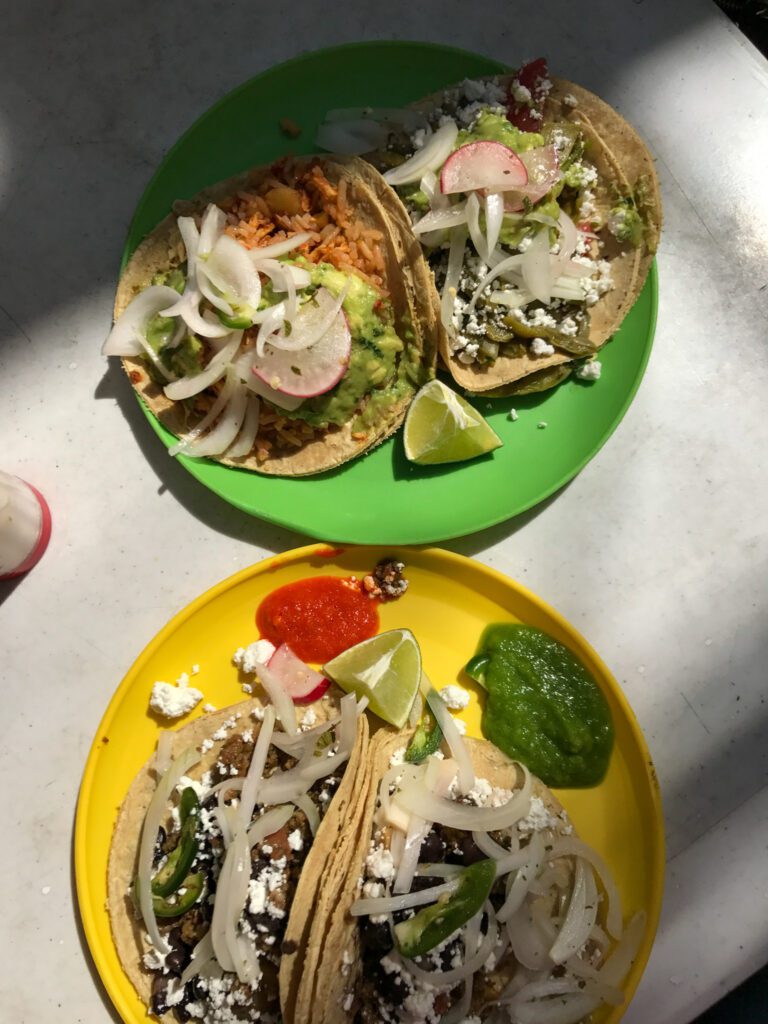
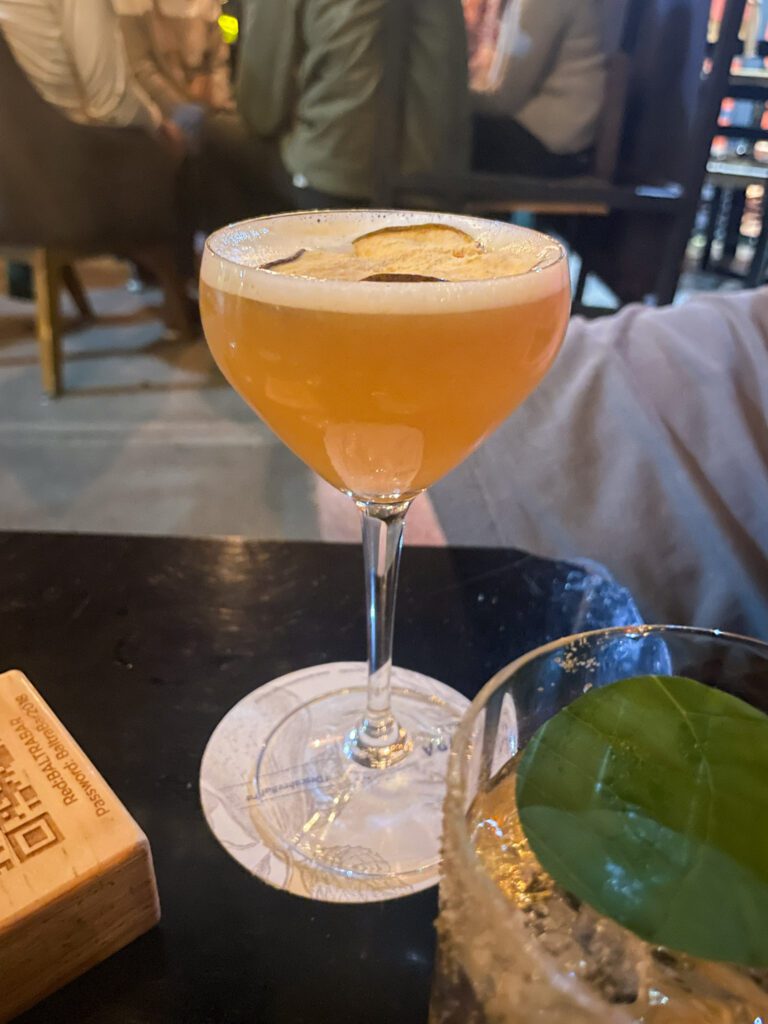
Today, La Condesa is one of the most upscale neighborhoods in Mexico City (we learned that the name “Condesa” means “countess,” which tells you everything you need to know), and has become particularly popular with expats and tourists over the past decade or so.
After spending a fair amount of time around La Condesa, it’s easy to see why. Between the parks, the vibrant sidewalk cafe/bar scene, and the tree-lined streets, it’s an exceedingly pleasant place to be.
One of our favorite parts of La Condesa is the ring around the park around Avenida Ámsterdam, which is a tree-lined street that forms a ring around Parque México (not immediately adjacent to the park, but one street over) that is split down the middle, with a walking path between two lanes of traffic.
We love a good morning or evening stroll around the ring, enjoying the sights and sounds of La Condesa.
Oh, and the number of dogs per capita must be about 10x higher in La Condesa than any other part of Mexico City because the parade of cute dogs is nonstop, especially when you’re around either of the two parks.
Similar to Roma Norte, La Condesa faces challenges around gentrification and an ever-increasing cost of living that has pushed local residents and businesses out in favor of expats, tourists, and businesses serving them.
It’s a challenge that every hip neighborhood in every city around the world eventually faces, and it’s something that’s worth being aware of (though we wouldn’t say it’s a reason not to stay here…maybe avoid using Airbnb here though and save that housing for residents).
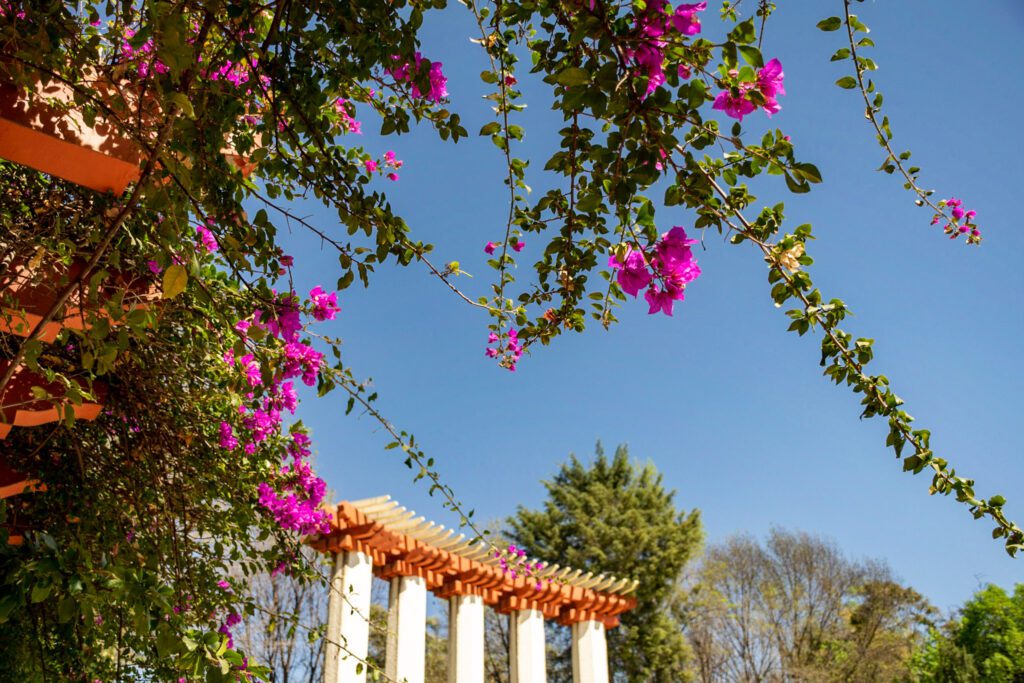
Pros and Cons of Staying in La Condesa
Spoiler alert: the pros and cons of La Condesa are going to look fairly similar to Roma Norte with a slight twist (mostly due to the duo of parks that form the backbone of the neighborhood).
Here are the pros and cons of choosing La Condesa as your home base in Mexico City, at least as we see them.
Pros of Staying in La Condesa
- It’s a very convenient location. There’s no way around it. La Condesa is a very, very convenient home base for exploring the rest of Mexico City. To the northwest, you have Bosque de Chapultepec and Juárez, across the park is Polanco. To the east is La Roma and the Centro Histórico. And, because it’s on the southern end of the trio of central neighborhoods that lead our recommendations, it’s a relatively easy journey to Coyoacán to the south.
- It’s very walkable. Similar to Roma Norte, everything within that trio of neighborhoods we’ve talked about a few times (Condesa, Roma, Juárez) is within walking distance if you stay here. So is Bosque de Chapultepec, which makes for a lovely morning or late afternoon stroll. Plus, you have two big parks forming the spine of La Condesa – Parque México and Parque España – that also are an extremely pleasant place for a walk.
- The streets are charming and leafy. Not only is everything walkable, but it’s a great place to wander around. Between the greenery everywhere, the two parks, and the plethora of shops, bars, and restaurants lining the streets, it’s worth spending an afternoon wandering around La Condesa, even if you don’t stay here.
- There are a ton of great places to eat and drink. Similar to Roma Norte, the concentration of great places to eat and drink in La Condesa is a little overwhelming. Whether you’re on the hunt for some of the best coffee and cocktails in Mexico City, tacos, or a more upscale dinner, you’ll find it in La Condesa.
Cons of Staying in La Condesa
- It’s expensive. As you might expect based on the name alone (“Countess” in Spanish), this is one of the most upscale places to stay. Which means that there’s no avoiding the fact that it’s going to be relatively expensive. Sometimes not even relatively – we’ve seen rooms going for $400USD at some of the nicest places here. However, there are still some relative values to be had, and we’ve tried to lean that way in our hotel selections below.
- It’s full of expats and tourists. There’s no getting around it – like Brooklyn in NYC, the Mission in San Francisco, or Capitol Hill in Seattle (and Roma Norte nearby), La Condesa has gone through the cycle of gentrification and has become a neighborhood of relative newcomers as local residents have been pushed out due to rising housing costs. It’s not something to stop you from staying here, but it is definitely a consideration and something to keep in mind as you interact with people who live in CDMX and are feeling that pressure.
- There aren’t very many places to stay. La Condesa is residential, which means that there aren’t all that many hotels and guesthouses to be had. As you go south of Parque México, you’ll start to find a few more options (and they’re all walkable to the rest of the neighborhood).
The Best Places to Stay in La Condesa
Here are a few places to stay in La Condesa that stood out to us as we were researching for both our own trip, and this guide.
The Red Tree House
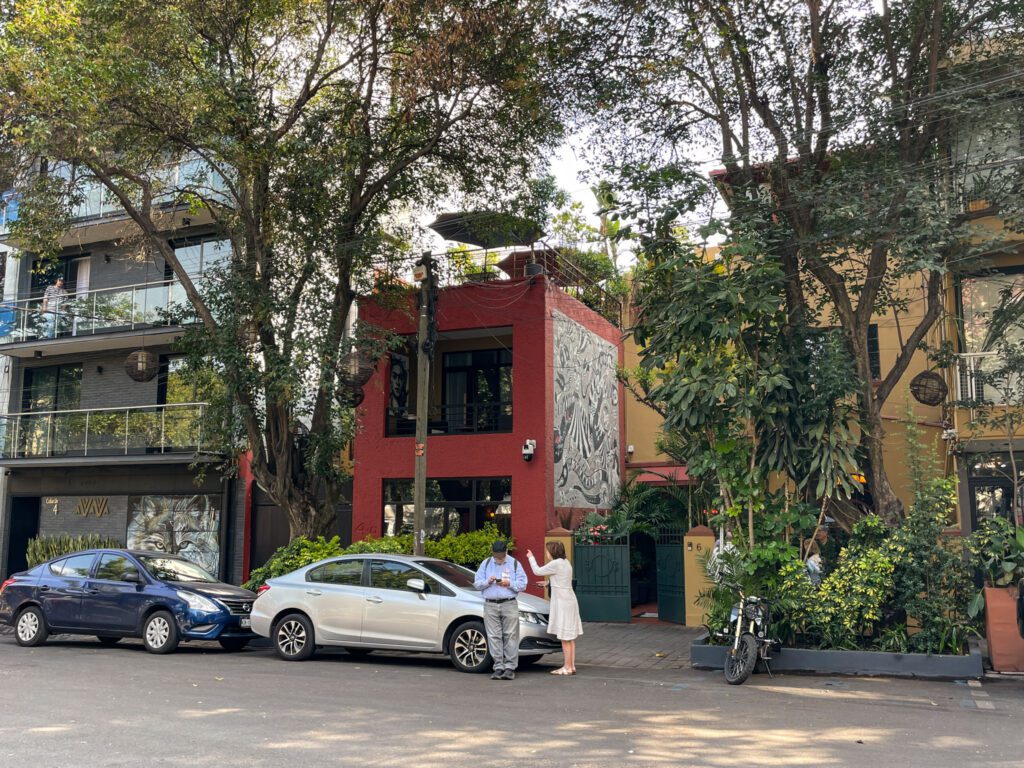
We’ve wanted to stay at the Red Tree House, a guesthouse in the heart of La Condesa, since our very first trip to Mexico City. Alas, it has been sold out for our first two trips, and didn’t work for a group on our latest trip.
This isn’t a luxury boutique hotel, this is a charming bed and breakfast with friendly, down-to-earth staff.
It’s less than two blocks from the southern end of Parque México, which means you have the best of La Condesa right outside your front door. It’s also a good location for accessing the metro, which is roughly four blocks away.
No two rooms here are the same, and some are compact traditional hotel rooms with one bed, some have two queen beds, and some have a little more space and an ensuite kitchenette.
Our favorite is the “treehouse,” which is a compact apartment on the top floor with its own private rooftop terrace. It’s tiny, so it’s only really good for a solo traveler or couple that’s cool with sharing a full sized bed.
Breakfast is included in the room rate, and it’s a home cooked affair.
Book as early as humanly possible, because there are only a handful of rooms and, based on our experience, they absolutely do sell out.
Casa Decu
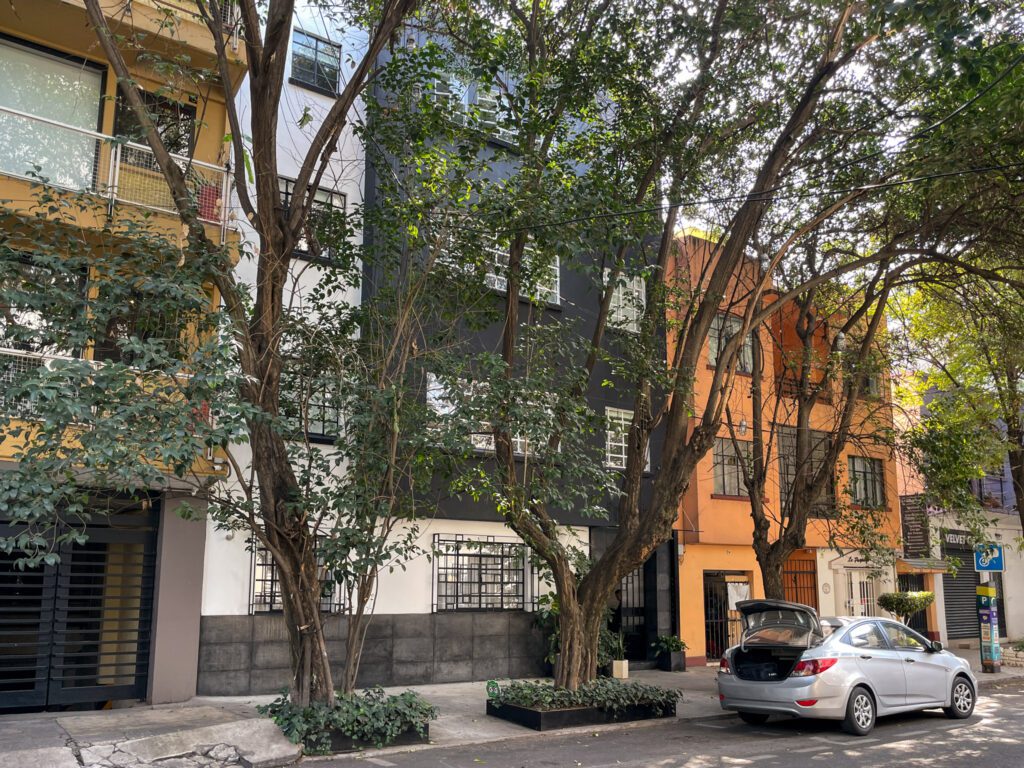
This boutique hotel is on the same block as the Red Tree House, which means the location is excellent.
The rooms here are all called suites, and they’re split into four tiers from basic hotel-style rooms (ironically called “executive suites” despite being the lowest tier) up to split-level two bedroom, two bathroom suites.
Most rooms have some sort of kitchen facilities – like a refrigerator and microwave – but not really enough to cook a full meal in. The duplex suite does have a stovetop, for what it’s worth.
Like many of the properties we’ve chosen for this guide, there’s a rooftop deck available for guests. And there’s a continental breakfast included in the room rate, which is served up on the rooftop (with a more hearty cooked-to-order breakfast available for extra cost).
Fungi Hostal Condesa
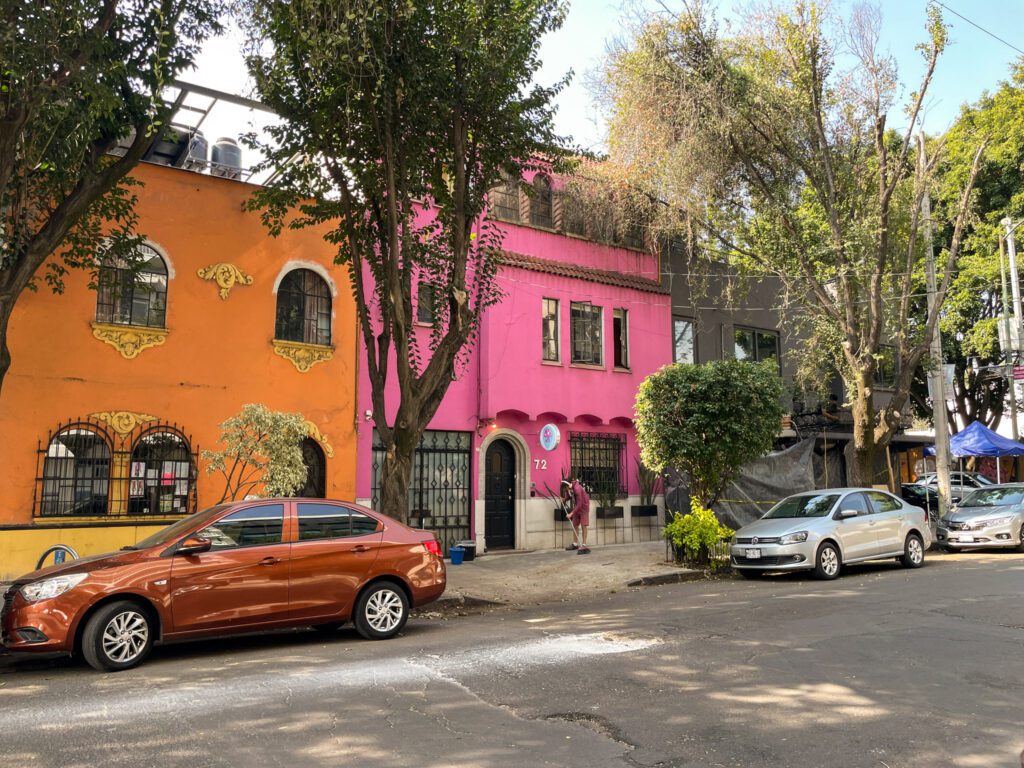
One of the most affordable places to stay in either Roma Norte or La Condesa, Fungi Hostal is a fantastic option for budget travelers. It’s a few blocks away from both of La Condesa’s parks, and a ten minute walk to the greenery of Bosque de Chapultepec.
They have a nice mix of dorm rooms (four beds max – queen bed on the bottom, single bed on the top) with some exclusively for women, and some private rooms with shared bathrooms.
As you might expect from a hostel, the rates are low and the common areas are plentiful. There’s a garden, a rooftop garden, and a couple of interior common areas. Plus, a shared kitchen.
Juárez / Zona Rosa: Equally Central, More Affordable
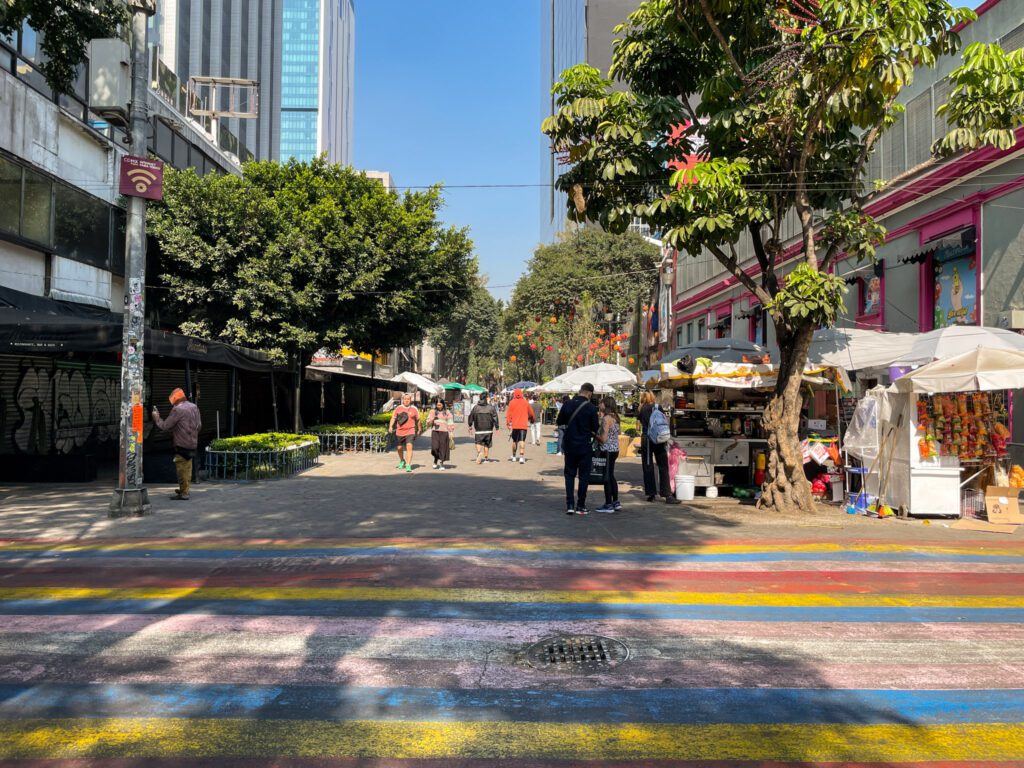
First, let’s talk about the relationship between these two neighborhoods.
In short, Colonia Juárez is a bigger slice of land that runs from the eastern border of Bosque de Chapultepec over to the Centro Histórico while Zona Rosa is a smaller slice of that neighborhood known for shopping, nightlife, and as the home of Mexico City’s LGBTQ+ community.
Juárez has seen a similar rise, fall, and then rise again as Roma Norte, as it was developed over the course of Diaz’s reign in the late 19th/early 20th Centuries, saw a stall in development and regression in the 80’s, and then became the bohemian, artist haven that led to gentrification over the past decade or two.
Paseo de la Reforma is the main street that runs through the center of the neighborhood.
Paseo de la Reforma is a wide, multi-lane boulevard that looks like it could be straight out of a European city like Paris or Madrid, which is unsurprising once you learn that it was commissioned by Austrian-born Emperor Maximilian (who briefly controlled the Mexican Empire for a hot second) and designed by an Austrian.
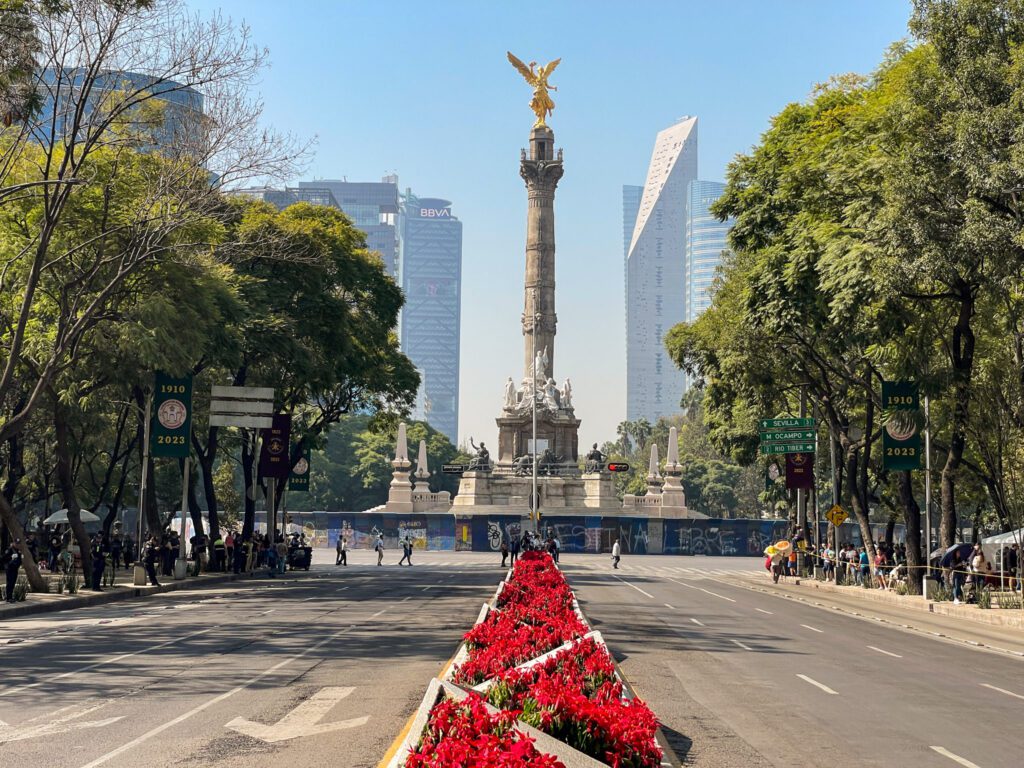
Paseo de la Reforma is also where you’ll find the Angel of Independence (Monumento a la Independencia), which celebrates the 100 year anniversary of Mexican Independence.
Big celebrations in the city tend to take place here. Like the big parade – which we walked through – on Día de la Revolución (Revolution Day) celebrating the toppling of Porfirio Díaz and the establishment of Mexico’s current form of government, including its constitution.
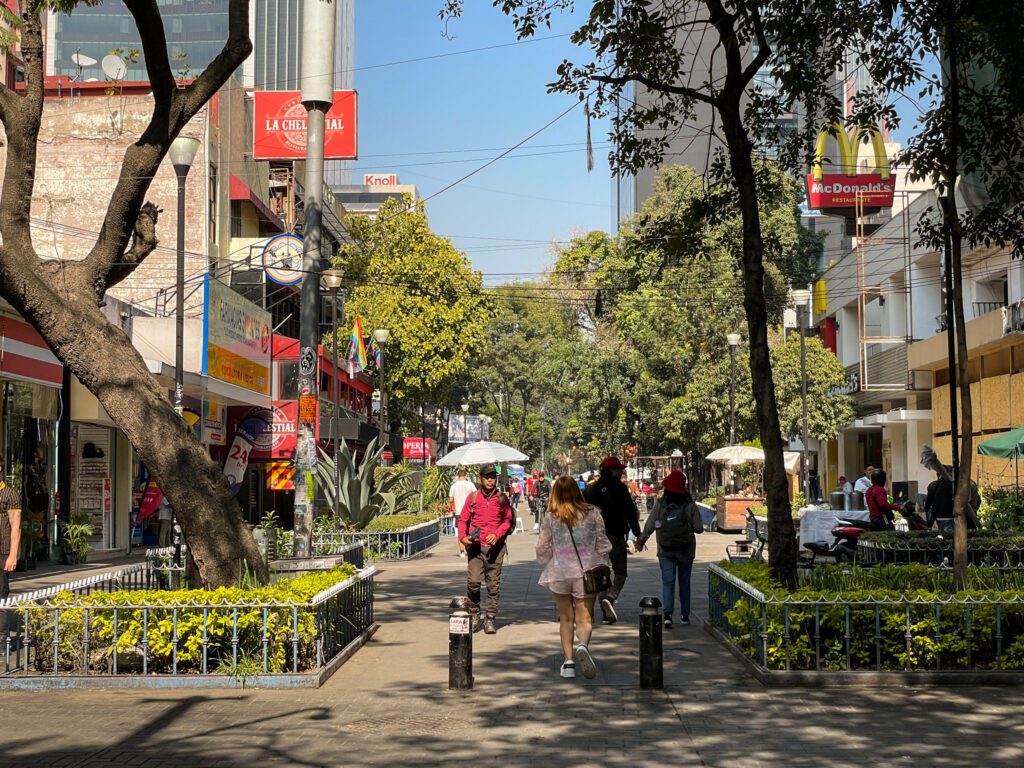
Zona Rosa, on the other hand, is a smaller slice of that bigger neighborhood that is known for a couple things, mostly shopping (there are a couple of pedestrian-only streets full of shops, bars, and restaurants) and nightlife.
The area is immediately north of Glorieta de los Insurgentes (which is a metro station – here on Google Maps) and southeast of the Angel of Independence.
Today, Zona Rosa is known as the home to Mexico City’s gay community, and the annual pride parade down Paseo de la Reforma looks like quite the spectacle.
This area has pros and cons, and is a little more of a mixed bag than Roma Norte or La Condesa.
It’s an area of contrasts, with huge, modern buildings towering over older, occasionally crumbling buildings. Wealthy foreign tourists staying at one of the expensive hotels in the area walking past street vendors hawking a variety of food, drinks, or electronics.
Now, to us, this is not really a surprise. Most areas known for nightlife and counterculture movements tend to have some problems related to those things.
That being said, it’s just a consideration. Particularly for families – if you have kids, we’d avoid staying in Zona Rosa and focus on the area on the north side of Paseo de la Reforma.
We would totally stay here, especially given the number of hotel options and their relative affordability.
If we were going to stay here, we would choose a place on the southern side of Paseo de la Reforma around Av. Insurgentes, which we think is a more charming and interesting place to stay (though, notably, it also suffers from some of those aforementioned issues more than the upscale places on the other side of the avenue).
Pros and Cons of Staying in Juárez / Zona Rosa
Here are the pros and cons of staying in Juárez as we see them.
Pros of Staying in Juárez / Zona Rosa
- It’s more affordable. Unlike Roma Norte and La Condesa, where affordable places to stay are few and far between, the plethora of options here mean that there’s a wider range of prices. Yes, you could spend $500 USD a night on a room at the Four Seasons, but there are also plenty of much cheaper options to be had.
- There are tons of hotel options. More than any other area in Mexico City, this area has an abundance of nice hotels (mostly thanks to its focus on foreign tourists over the past two decades). The nicest hotels in the city are here (like the Four Seasons), but there’s also a good range of more affordable options.
- It’s walkable to…everything? It’s one of the few neighborhoods that is walkable to Roma Norte, Condesa, the historic center, and Bosque de Chapultepec. Theoretically, if you’re up for a lot of walking (we are!), you could walk almost everywhere on your itinerary.
- Solid food and drink options. Particularly on the eastern end of the neighborhood (east of Av. Insurgentes). Amaya and Cicatriz are two of the top spots here. Particularly Amaya, which has a focus on Mexican natural wines.
Cons of Staying in Juárez
- It’s less charming. As a neighborhood that’s part commercial center, part nightlife hub, it’s not going to have the uber-charming tree-lined streets that you’ll find in the other two neighborhoods we covered. That doesn’t mean it isn’t kind of charming in its own right, it’s just a different vibe.
- It’s busy and loud. Every time we’ve walked through this area, we’ve been surprised at how busy it is. Which kind of makes sense given the huge hotels and towering office buildings. It’s not Centro Histórico levels of madness, but it is a consideration. It’s not likely to be particularly quiet or quaint.
Coyoacán: A Charming Neighborhood Both More Affordable & Further Out
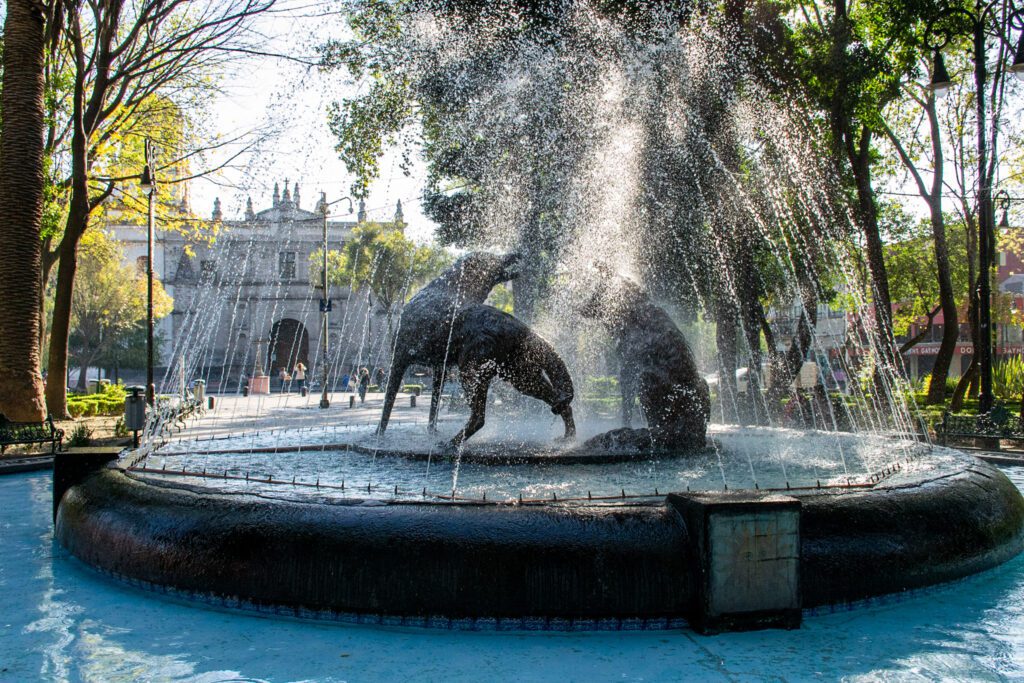
Coyoacán is a completely different type of recommendation than the previous three, which is why we decided to include it.
Coyoacán feels more like a small town, with its smaller buildings and cobblestone streets. It reminds us more of a city like Guanajuato (a city we love) than Mexico City.
Which makes sense when you realize that it was, in fact, formerly an independent town before being swallowed up by the expanding metro area of Mexico City.
Unlike the rest of Mexico City, which is generally laid out in a straightforward grid with some quirks here and there, Coyoacán is a maze of narrow, single lane cobblestone streets lined with colorful buildings.
We decided to stay in Coyoacán for a portion of our long trip to Mexico City a few years ago, and we really do love this area (even if it’s not the most convenient for a first timer or a short stay).
The centerpiece of Coyoacán is the twin plazas that adorn the historic center of the neighborhood – Jardín Centenario (with the Coyote fountain) and Plaza Hidalgo.
The very old 16th Century Parroquia San Juan Bautista – which was originally built by Hernan Cortes after his conquest of Tenochtitlan in the 16th Century – towers over both plazas, which are consistently buzzing with people at all hours.
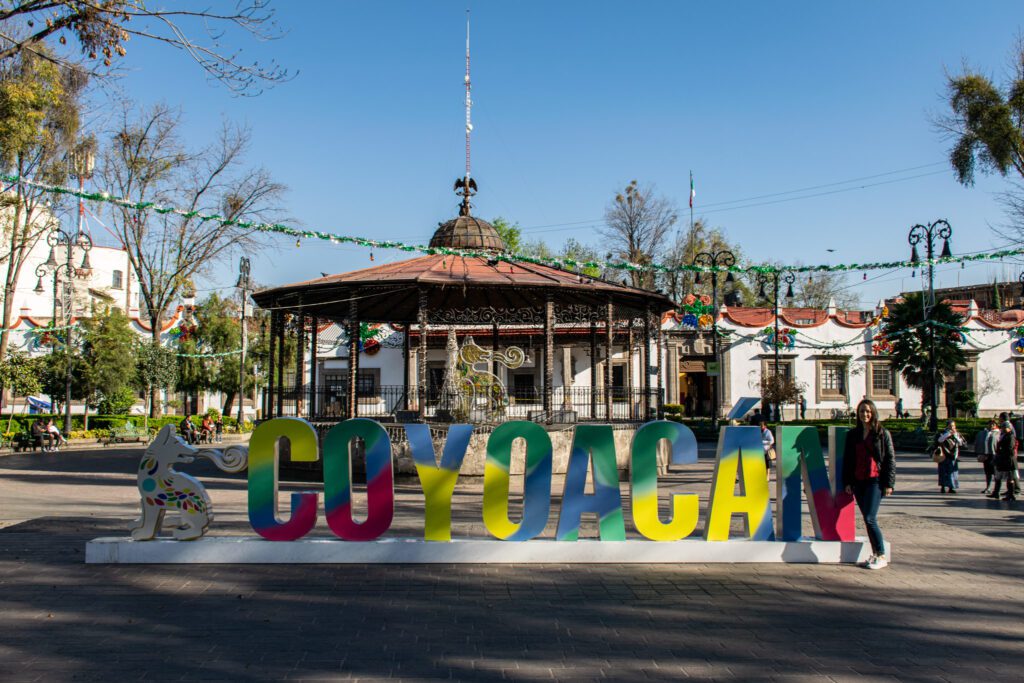
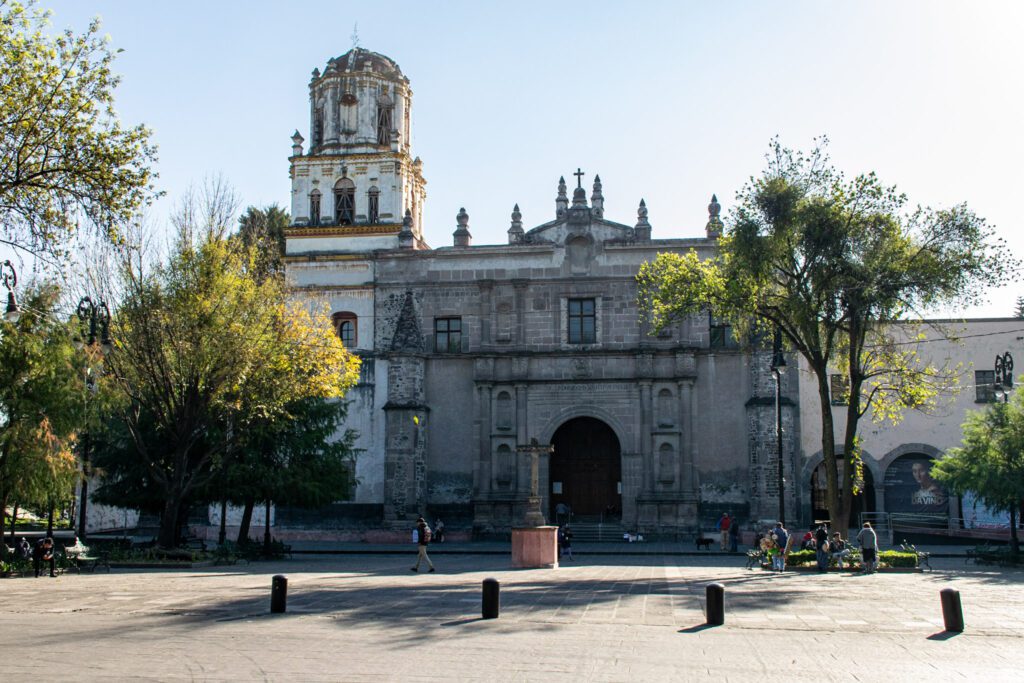
In the blocks around the two plazas, you’ll find plenty of shops, bars, and restaurants to keep you busy for a few days.
Including the Mercado de Coyoacán, Cafe Avellaneda (one of our favorite coffee shops in Mexico City), and, of course, the Frida Kahlo Museum (also known as Casa Azul).
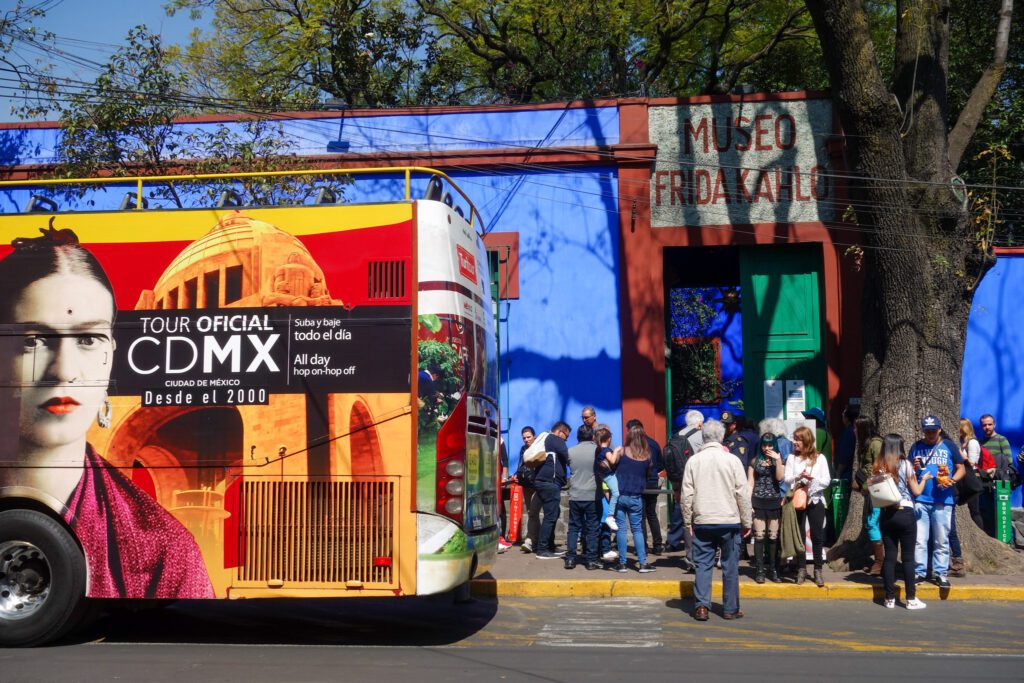
By far the biggest con of staying here is that it’s not particularly convenient because it’s much further south than any of the other areas on this list. That fact, combined with the fact that it’s a little bit of a walk to the closest metro stop, means that you’re likely going to be spending a little more time on getting around.
Overall, we’d recommend it – particularly for families, budget travelers, or longer trips – but it’s definitely not the best place to stay for your first trip or a trip less than four or five days, when you’ll want to stay more central to maximize your time.
Pros and Cons of Staying in Coyoacán
Here are the pros and cons of choosing Coyoacán as a home base for exploring Mexico City, as we see them.
Pros of Staying in Coyoacán
- Colonial charm. While we have mixed (read: fairly negative) feelings about the period of colonization in Mexico and other parts of Latin America, we do enjoy the architectural style. And Coyoacán is a good place to see it in Mexico City given that it was the center of Spain’s presence in the city back in the 16th Century, and has been somewhat preserved over the centuries since. Colorful buildings, narrow cobblestone streets, and a very confusing street layout are hallmarks of the style, and Coyoacán has all of them.
- The small town feel and (relatively) slower pace. We’re not saying this is a quaint area – there’s still a buzzing energy at basically all hours that comes from locals going about their business – but it is a different pace than the historic center, which can be overwhelming at peak times. This is the kind of place where you can sit in the plaza for 30 minutes and watch the world go by and not feel like you should be doing something else to maximize your time.
- It’s significantly more affordable. The tradeoff for the location, which is further out than the other neighborhoods above, is the price. Prices here are going to be significantly cheaper than Rome Norte or La Condesa. Even the more expensive places top out at ~$150 USD a night (versus $300-$400 USD in the aforementioned areas), with most options being cheaper than that.
Cons of Staying in Coyoacán
- It’s pretty far from the main sights. Coyoacán sits about 8-9km south of La Condesa and Roma Norte, and given the constant state of traffic on most days in Mexico City, it’s going to take you 30+ minutes in each direction by car or metro (more on the metro in a second).
- The metro connections are okay, at best. The closest metro station (aptly named “Coyoacán”) is a full 20 minutes on foot from the two plazas. Given that you’ll need to leave the neighborhood on basically every day you’re here, you’re looking at a hefty time commitment to stay in Coyoacán, which may or may not be worth it to you (probably not great for first timers or short trips).

I just want to say thank you
We just want to say “you’re welcome!” Hope you found this guide useful and enjoyed your trip.